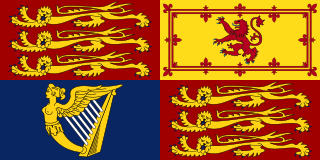
The royal standard of the United Kingdom is the banner of arms of the monarch of the United Kingdom, currently Charles III. It consists of the monarch's coat of arms in flag form, and is made up of four quarters containing the arms of the former kingdoms of England, Ireland, and Scotland. There are two versions of the banner, one used in Scotland in which the Scottish quarters take precedence, and one used elsewhere in which the English quarters take precedence.
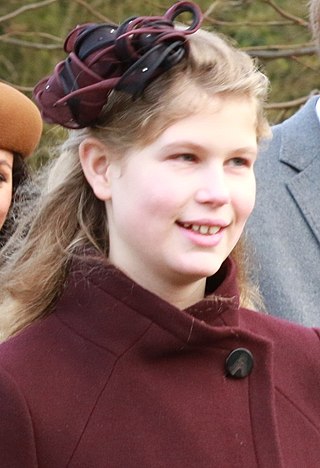
Lady Louise Alice Elizabeth Mary Mountbatten-Windsor is the daughter of Prince Edward, Duke of Edinburgh, and Sophie, Duchess of Edinburgh. She is the youngest niece of King Charles III. Born 8th in line to the British throne, she is now 16th.
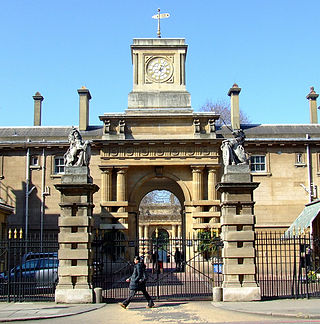
The Royal Mews is a mews, or collection of equestrian stables, of the British royal family. In London these stables and stable-hands' quarters have occupied two main sites in turn, being located at first on the north side of Charing Cross, and then within the grounds of Buckingham Palace.

The Irish State Coach is an enclosed, four-horse-drawn carriage used by the British Royal Family. It is the traditional horse-drawn coach in which the British monarch travels from Buckingham Palace to the Palace of Westminster to formally open the new legislative session of the UK Parliament.

The Gold State Coach is an enclosed, eight-horse-drawn carriage used by the British royal family. Commissioned in 1760 by Francis Rawdon-Hastings, 1st Marquess of Hastings for King George III, and designed by Sir William Chambers, it was built in the London workshops of Samuel Butler. It was commissioned for £7,562. It was built for George III's coronation in 1761, but was not ready in time; it was completed in 1762.
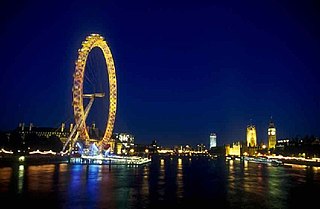
The Golden Jubilee of Elizabeth II was the international celebration held in 2002 marking the 50th anniversary of the accession of Queen Elizabeth II on 6 February 1952. It was intended by the Queen to be both a commemoration of her 50 years as monarch and an opportunity for her to officially and personally thank her people for their loyalty.

The King's Bargemaster is a subordinate officer of the Royal Household of the Sovereign of the United Kingdom. Until the mid-19th century, the Royal Family frequently used a royal barge for transport along the River Thames. The role of the King's Bargemaster was to oversee this. The tradition of the Bargemaster dates back to 1215, with the signing of Magna Carta at Runnymede. The role is now largely ceremonial.
The Household Cavalry Mounted Regiment (HCMR) is a cavalry regiment of the British Army tasked primarily with ceremonial duties. Part of the Household Division, it is classed as a regiment of guards, and carries out mounted ceremonial duties on State and Royal occasions. The HCMR is one of two operational units that form the Household Cavalry (HCav), the other being the Household Cavalry Regiment (HCR), a formation reconnaissance regiment, with front-line combat duties.

Windsor Grey is a moniker for the grey horses used by the British monarchy to pull carriages and state coaches in ceremonial processions such as those for coronations, royal weddings, Trooping the Colour, and the opening of Parliament. They are named for Windsor Castle where they were originally stabled, though today they live at the Royal Mews near Buckingham Palace.
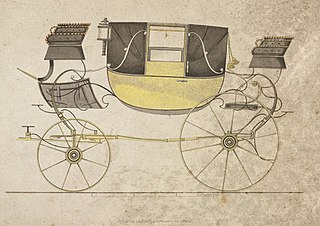
In coachbuilding, a landau is a four-wheeled carriage with a roof that can be let down. It was a luxury carriage. The low shell of the landau provides maximal visibility of the occupants and their clothing, a feature that makes a landau still a popular choice for Lord Mayors in the United Kingdom on ceremonial occasions.

James Alexander Philip Theo Mountbatten-Windsor, Earl of Wessex, styled Viscount Severn from 2007 until 2023, is the younger child and son of Prince Edward, Duke of Edinburgh, and Sophie, Duchess of Edinburgh. He is the youngest nephew of King Charles III. He was born during the reign of his paternal grandmother Elizabeth II, at which time he was 8th in line to the British throne. He is currently 15th.

The Australian State Coach is an enclosed, six horse-drawn coach used by the British Royal Family. Constructed in 1986-88, it was the first royal state coach to have been built since 1902. It was presented to Queen Elizabeth II of Australia and the United Kingdom in Canberra on 8 May 1988, as the official gift on the occasion of the Australian Bicentennial, and was first used in November of that year by the Queen at the State Opening of Parliament in the UK.

The Diamond Jubilee State Coach is an enclosed, six-horse-drawn carriage that was made to commemorate Queen Elizabeth II's 80th birthday, but completion was delayed for nearly eight years. Eventually, it became a commemoration for the Queen's Diamond Jubilee.

The Palace of Holyroodhouse, commonly known as Holyrood Palace, is the official residence of the British monarch in Scotland. Located at the bottom of the Royal Mile in Edinburgh, at the opposite end to Edinburgh Castle, Holyrood has served as the principal royal residence in Scotland since the 16th century, and is a setting for state occasions and official entertaining.

The coronation of Elizabeth II as queen of the United Kingdom and the other Commonwealth realms took place on 2 June 1953 at Westminster Abbey in London. She acceded to the throne at the age of 25 upon the death of her father, George VI, on 6 February 1952, being proclaimed queen by her privy and executive councils shortly afterwards. The coronation was held more than one year later because of the tradition of allowing an appropriate length of time to pass after a monarch dies. It also gave the planning committees adequate time to make preparations for the ceremony. During the service, Elizabeth took an oath, was anointed with holy oil, was invested with robes and regalia, and was crowned Queen of the United Kingdom, Canada, Australia, New Zealand, South Africa, Pakistan, and Ceylon.

The Glass Coach is one of the principal State carriages of the British monarch. Built by Peters & Sons of London in 1881, it had originally been designed as a sheriff's coach, but was purchased by the Crown in time for the coronation of George V in 1911.

The wedding of Prince Henry, Duke of Gloucester, and Lady Alice Montagu Douglas Scott took place on Wednesday, 6 November 1935, in the private chapel at Buckingham Palace. A larger public ceremony had been planned for Westminster Abbey, but plans were scaled back after the bride's father, the 7th Duke of Buccleuch, died of cancer on 19 October.

The state and royal cars of the United Kingdom are kept at the Royal Mews, Buckingham Palace, where a wide range of state road vehicles are kept and maintained. The vehicles also are stored at other royal residences as required.

The Platinum Jubilee Pageant was held on Sunday, 5 June 2022 near Buckingham Palace, as part of Queen Elizabeth II's Platinum Jubilee celebrations. Conceived and directed by David Zolkwer with Pageant Master, Adrian Evans, it featured over 10,000 people from across the United Kingdom and the Commonwealth and combined street arts, music, puppets, carnival and costume to celebrate the Queen's reign, as well as honouring the collective service of people and communities across the United Kingdom.

The 2023 Trooping the Colour was held on 17 June 2023. Over 1,500 soldiers, 300 horses, and 400 musicians took part in the ceremony, the first to be held during King Charles III's reign, and for his first Official Birthday.





















